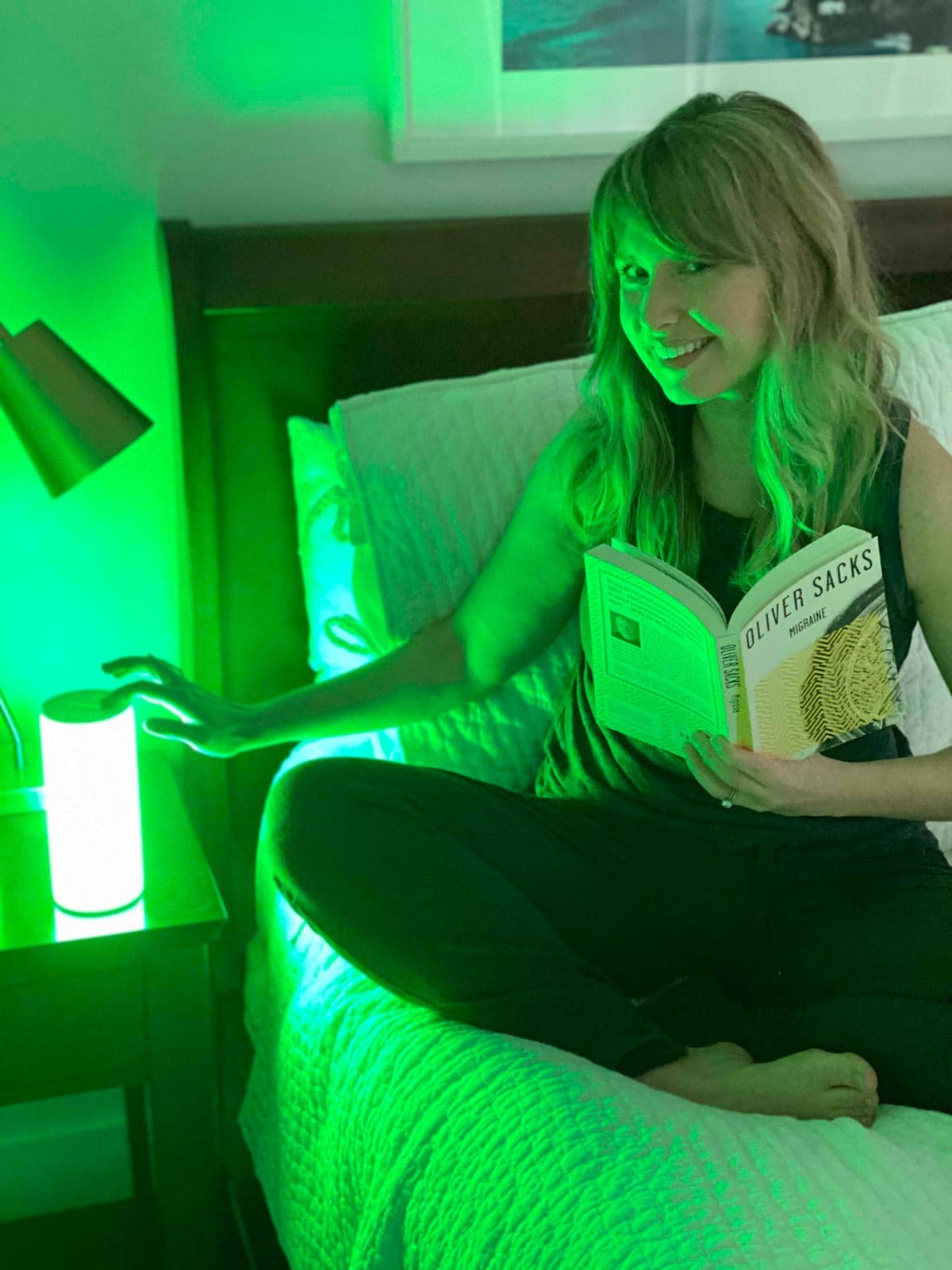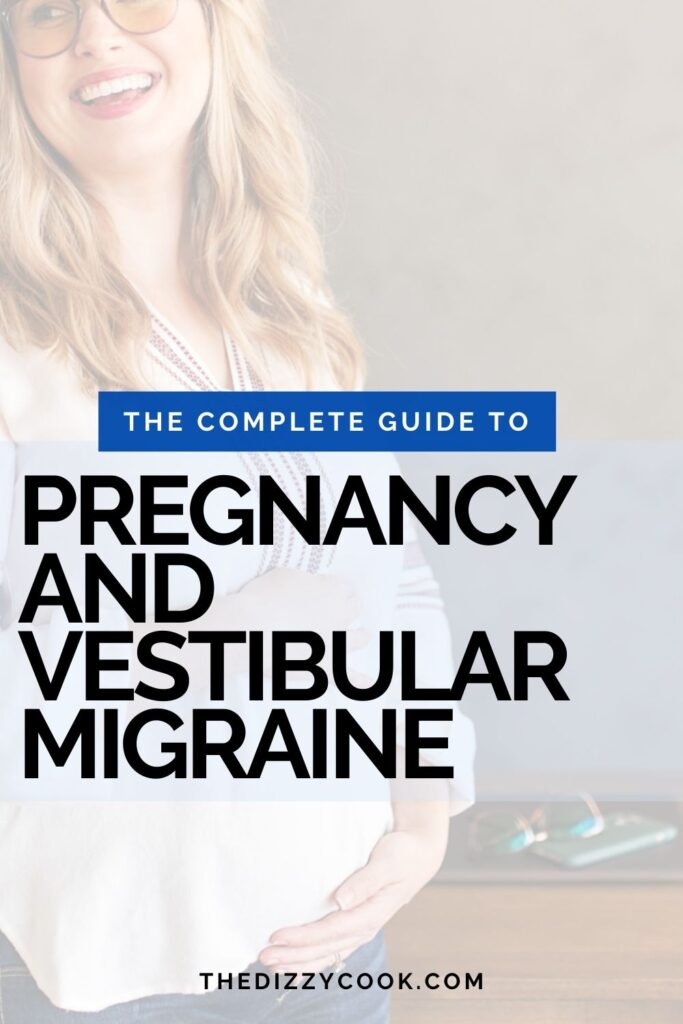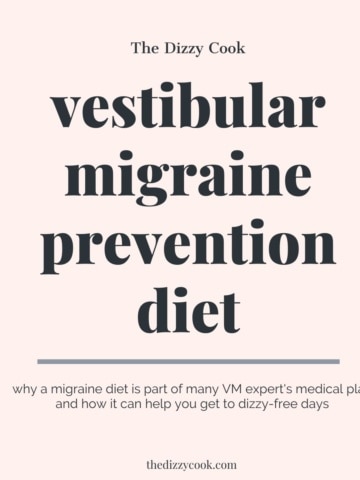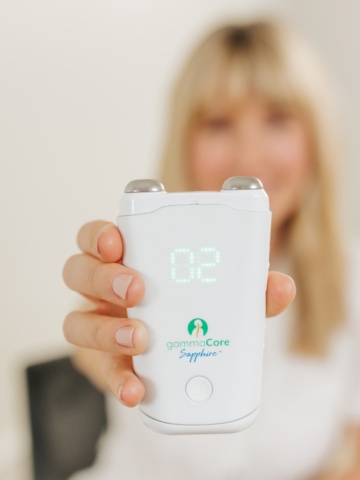When you have to manage a chronic illness like vestibular migraine, the idea of pregnancy, birth, and postpartum can be quite overwhelming. Because I was diagnosed with vestibular migraine about the same time we were thinking about starting a family, it was something that weighed heavily on my mind. How can one even think about having a child to care for when I can barely drive or walk?
For a while, I knew I had to put off starting a family. But once I found the right doctor and got on the right migraine treatment plan, I started to see a light at the end of the tunnel. At that point, the fear was more about messing up all the progress I had made with hormonal changes. I remember asking myself if I had to go back to square one with my vestibular migraine, would it be worth it?
At the end of the day, I knew I was much better off now with a good team and migraine treatments that worked for me. I also knew that if I decided against having children because of my disorder, it felt like I was letting that rule my life. It had already stolen a career from me, and I hated it stealing the idea of a family for me as well. I grappled a lot with the risk vs. reward until I finally decided the reward outweighed the risk.
Little did I know we would struggle with infertility and have to go through IVF, which just added another layer of uncertainty. We were incredibly fortunate our first embryo transfer was successful. But after conquering one hurdle, I had a few more to clear.
Jump to:
- Migraine and Early Pregnancy
- Overcoming Anxiety
- Migraine and Nausea During Pregnancy
- IV Therapy
- Vestibular Migraine Symptoms During Pregnancy
- Vestibular-Friendly Exercises for Pregnancy
- Vestibular Migraine Medications and Pregnancy
- Migraine and Preeclampsia Risk
- Vertigo in Pregnancy
- Postpartum with Vestibular Migraine
- Things I've Learned for My Second Pregnancy
- Posts on Migraine and Pregnancy:
Migraine and Early Pregnancy
The first trimester while coping with vestibular migraine was my hardest. During our two week wait after the embryo transfer, I texted my friend Kayla every little symptom. One new symptom we both had pop up was headaches, which neither of us really experienced before.
Typically our symptoms included dizziness or lightheadedness, brain fog, and sometimes vertigo or derealization. The absence of head pain was what made our diagnosis of vestibular migraine so hard to get. Yet the first few headaches made me excited, because they can be a first sign of pregnancy.
During this period your options for pain relief are really limited. Because I was so nervous about miscarriage based on our past losses, I didn’t use anything outside of tylenol. A few things I relied on heavily that got me through the rest of the pregnancy were:
- Magnesium - which is so good for blood pressure during pregnancy as well.
- The Allay Lamp
- Hydration
- Meditation and Mindfulness, as well as CBT and Progressive Muscle Relaxation
- Blisslets

Overcoming Anxiety
I struggled heavily with anxiety my first few weeks, and it had not been that severe since I first was diagnosed with vestibular migraine. When I was about 7 weeks pregnant, we had a really horrible event and I began to spot that afternoon.
Based on all my losses, I called my doctors sobbing that this was probably another loss that was brought on by such an intense situation. My reproductive endocrinologist brought me in, and although it was early, we saw his heartbeat. My bleeding was actually caused by what’s called a subchorionic hematoma, which can be common with IVF pregnancies.
I immediately had to go on bed rest and this only increased my anxiety. Because I hadn’t needed a therapist in years and had no idea how to contact the one who helped me with my migraine journey, I reached out to my sweet therapist friend Kristi DeName, who ran through some wonderful techniques, like CBT, that helped calm me.
A few things that helped:
- Visualization - Visualized myself holding my baby and felt everything. Focused on what we were wearing, how heavy he would be, what he would smell like, what I would sing.
- Progressive Muscle Relaxation - There are so many videos on YouTube! Just search for it and find one you like.
- Guided Meditation - Specifically fertility meditations - yes you can find one for almost anything!
At night, I’d use my Allay Lamp, which although it didn’t help much with the dizziness, I found extremely soothing and also helpful for nausea. That brings me to the debilitating nausea.
Migraine and Nausea During Pregnancy
About week 7 was when the “morning” sickness hit me hard, and I could never figure out why it was called that as I typically felt ok in the morning, but super nauseated the rest of the day. Evenings were spent next to the toilet.
My first pregnancy I was just nauseous and sick, but not super severe (except for one week I got really sick in my second trimester and ended up in the hospital due to a bug). My second pregnancy I got hit hard with hyperemesis gravidarum and have thrown up almost every day for 37 weeks. I had a good stretch in my 2nd trimester for about a week.
Nausea does seem to be more common during pregnancy if you have a vestibular migraine disorder.
Some things that helped me my first pregnancy were:
- Anything sour - Sour candies especially! I’ve reintroduced citrus, but loved green apple flavors. Dried green apples and preggie pops were wonderful. I also loved Yum Earth’s natural suckers, which can be found at Whole Foods.
- Ginger beer - I got so tired of the ginger flavor everyone constantly recommended, but sipping on ginger beer did seem to help. My favorite brand was Regatta, which wasn’t too spicy.
- Oatmeal and smoothies were fairly easy on the stomach and filling.
- Relaxing with the Allay Lamp.
- Blisslets acupressure bands.
- Eye Mask and Neck Wrap
- Migraine Glasses
- B6 and Unisom and/or Diclegis.
For my second pregnancy with hyperemesis what helped me:
- Plain cream of wheat, sometimes with honey.
- Animal crackers, cantaloupe and green apples.
- Plain bean burritos
- Zofran - This is a last resort in the first trimester, usually if you have excessive vomiting and are losing a lot of weight. Unfortunately some side effects are headache and constipation, and this is where magnesium can help.
- gammaCore
Your OB might recommend Bonjesta, Diclegis, or Unisom and B6. Essentially they’re all the same thing, but insurance doesn’t like to cover Bonjesta or Diclegis (probably because men don’t get pregnant, but that’s a rant for another day). I would recommend searching GoodRx or making your own at home if your doctor allows it. It helped a little bit, but mostly I just had to power through.
The nausea let up a bit around 18 weeks with my first pregnancy. My second, I had a little relief at 22-26 weeks but my 3rd trimester it came back.
IV Therapy
IV Therapy is exactly what it sounds like - using IV fluids with different vitamins or treatments as a therapy option. Most people think of it for hangover cures, but for me, it was a quick way to get in fluids when I couldn’t keep anything down.
There was just one time that my sickness got so severe, I had to spend 2 nights in the antenatal floor of the hospital on fluids. But for the few times that I knew I was getting very dehydrated and would get really odd symptoms, like my fingers being so stiff I couldn’t type with them, a quick at-home IV would immediately get me feeling better almost immediately.
If you’re not pregnant, you can add vitamins for energy, or even magnesium and toradol for a migraine attack. They’re not cheap, ranging from $75-200, but it does cost a lot less than a visit to the hospital, so you have to weight the cost/benefit of them.
Vestibular Migraine Symptoms During Pregnancy
Overall, aside from the first trimester, I really only dealt with a few dizzy days here and there. Nothing too debilitating, but had to watch my footing sometimes on uneven pavement or rest on the couch instead of pushing myself. I’d say instead of me feeling 100% most days, I hovered around 90-95%, which really isn’t bad.
Because you read so many stories of people having their migraine symptoms increase, I was really scared of what would happen to me. I’m happy to report that essentially, my symptoms stayed pretty much the same as they were before I was pregnant.
I did have to manage my threshold more strictly and make sure to keep my triggers as low as possible. This meant trying to eat a migraine-friendly diet as best as I could and avoiding my known food triggers, keeping up with hydration and my sleep schedule, and using therapy techniques to decrease my stress. I also worked a lot on setting boundaries, and letting go of toxic situations or people. You’d be surprised at how much that can help, especially if you’re like me and have a tough time saying “no”.
Vestibular-Friendly Exercises for Pregnancy
As for exercise, after I was cleared from my SCH (subchorionic hematoma), I found myself doing best with walks or rowing. It is best to avoid any situations that could throw you off-balance easily so I avoided a lot of bending over, step ups, and lunges.
Squats, dumbbell incline rows, banded chest flys and incline push ups were helpful. I also did makeshift burpees where I put both arms on a box, stepped back one foot, then the other, then stood up. A lot of my time was spent doing restorative yoga.
Vestibular Migraine Medications and Pregnancy
When I wrote about my path of trying to conceive and IVF, I discussed that I was very open with my neurologist and my OB on what I was comfortable with taking. Because I had such a high-risk pregnancy, I decided to hold off on the Timolol eye drops, even though my doctors had approved them for use. If I would have experienced more dizziness, I would have probably added it into my treatment plan.
One thing that really helped me was a conversation I had with my OB about making myself a priority. If you can take care of yourself, you’re essentially giving your baby the best environment possible. For some people, that means taking medications. And although there’s a slight risk to taking migraine medication during pregnancy, the benefits can often outweigh the risks if it keeps you feeling good and in a stable place with your disorder.
Outside of Benadryl and Tylenol, a few commonly prescribed migraine medications and treatments during pregnancy are:
- Beta Blockers (I had timolol drops on hand)
- Cyproheptadine for acute relief.
- Nerve Blocks
- Neuromodulation Devices (like gammaCore)
- Certain triptans
- Diclegis or Bonjesta for nausea with Zofran as a last resort.
Some medications with higher risk that are prescribed:
- Certain antidepressants, like nortriptyline.
- Certain SNRI’s (most commonly Effexor/venlafaxine) and SSRIs.
I have friends who continued their antidepressants during their pregnancy and they had fewer complications than I did avoiding medications. It’s a personal decision between your and your physician, but do not feel guilty if that’s what you need to take care of yourself.
Migraine and Preeclampsia Risk
The truth is that people with migraine disorders often have an increased risk for developing preeclampsia. A study from 2019 analyzed associations between migraine and adverse pregnancy outcomes, finding that there was an increased risk for preeclampsia and other issues. While another study from 2005 showed women with a history of migraine attacks had a 1.8 fold increase of risk, with overweight women carrying a 12 fold increase.
I personally invested in an at home blood pressure cuff just to keep an eye on it. If you have a big concern, bring it up with your OB-GYN.
Vertigo in Pregnancy
The most challenging part of my experience with vestibular migraine and pregnancy was the actual birth, which induced a horrible vertigo episode. Because I had several risk factors that had to do with my age, 2 vessel cord, the large size of my baby, polyhydramnios, and IVF history, we scheduled an induction at 39 weeks.
The evening before they offered something to help me sleep, which I took in an effort to be well-rested and reduce my chance for an attack. Everything seemed to be going well. I was dilating on schedule and I got the epidural put in without a hitch before the pain really ramped up. Then, I hit a wall. I was no longer dilating the way I should and started having significant pain, despite the epidural. When my OB came in to check, she found I had developed a hematoma that was a significant size. This had to do with my unique anatomy and the fact that George was very large. He was trying to get out, but kept hitting the same area, which was causing a hematoma. It was no longer safe to proceed with a vaginal birth.
Things got super crazy after that and my anxiety went through the roof. At the time, the hospital required labor in a mask when other people were in the room. As they wheeled me to the operating room I had horrible motion sickness come on very quickly. Before I could even warn them, I had a severe vertigo attack and threw up in my mask, which spilled all over my face. I couldn’t stop crying from how traumatic the whole situation was.
I told my anesthesiologists that I was experiencing a vestibular migraine vertigo attack. They were on it, giving me everything I needed to stop the attack. Unfortunately it made me super sedate. I don’t even remember much from when George appeared, and I had to wait a very long time to hold him.
If it’s in the cards to have another child, I will need to have a scheduled c-section. Hopefully being prepared and knowing what to expect will cut out the situation that triggered my vertigo attack. But your first time, you never know!
My best advice is just to warn all your providers that you live with migraine and what exactly that entails. Be upfront about moving you around if you are triggered by motion. If you’re nervous about the epidural, ask for the head of anesthesia to perform your placement. Don’t be afraid to advocate for yourself. Sometimes this is easier the second time around.
Postpartum with Vestibular Migraine
Early postpartum, like the first 6 months, was the most difficult period for me when it came to managing vestibular migraine. The best thing I did was to come up with a plan with Dr. Beh before I gave birth. Our plan of attack was to stick with what was working for me, and we have 3 other options in case that plan failed.
Lack of sleep is one of my triggers, and between that, hormones, struggling to breastfeed, and an insane amount of stress coming home to an ice storm with mass power outages in Texas, I was a wreck. This is what I wish I would’ve done differently.
Sleep - Consider a night nurse, at least a few nights a week. The more I talk to other women with vestibular migraine who have done this, the more I’ve heard that it was one of the best things they ever did. While you think you have help with your spouse or family, it’s very likely you will be the one always up with the baby if you're breastfeeding. Paying someone financially may force you to take the rest more seriously. I had a few vestibular migraine mom's on instagram tell me they requested donations for this instead of gifts.
Breastfeeding - Some people have this come naturally and it’s a beautiful situation for them…that was not me. We went through months of tongue tie revisions, 4 different lactation consultants, osteopathic work, food allergies, and finally failure to gain weight...which finally made me give it up at 5 months in. I worked so hard at trying to make it work that it drove me crazy to give it up. I think this contributed a lot to my heightened vestibular symptoms and postpartum anxiety. When I finally did, a huge weight lifted. I mourn the days I spent crying and not enjoying the time with my baby because of this.
Medications and Supplements - If you do find yourself in a situation where you have debilitating postpartum anxiety and can’t even sleep when you have help, speak with your doctors about tryptophan, magnesium, lorazepam, and zoloft as options. By doctors, I mean a neurologist and a pediatrician.
Ask the Pediatrician - Your neurologist will know what is best for your head, but they are not experts about dosages that are safe for breastfeeding. This is where the pediatrician can be amazing! Both my OB and neurologist had told me I had to wait a few hours to breastfeed at my prescribed dosage, but our children’s hospital was able to approve immediate use at my dosage. This helped me immensely.
One tip other moms shared with me - this too shall pass. The first few weeks are truly the hardest. And then it gets a little bit easier as time goes by. Although I do feel like my head is much more sensitive to vestibular migraine attacks now, I also have 100% days again - so there is hope.
By sharing my experience, I hope that I can help some of you who are on the fence as well. I think too often we hear the negative stories, rather than the positive. Managing vestibular migraine during pregnancy isn’t easy, but it can be done with a good team and a solid plan.
Things I've Learned for My Second Pregnancy
My second pregnancy has been so much different than my first. Because of my infertility and pregnancy loss issues, we were expecting to have to do an embryo transfer again - but life had different plans! Surprisingly I got pregnant this summer and it stuck. We are still in shock.
I think having a girl instead of a boy made me more prone to hyperemesis gravidarum, since I was not that sick with my son. Outside of the vomiting and nausea, my vestibular migraine symptoms have kept in check.
For a while I developed occipital neuralgia my neurologist thought could be from the excessive vomiting. We almost did a nerve block, but I was able to avoid it with cupping and dry needling.
Overall here are some things I've changed:
- Gave myself grace - Because I was so sick and also had a toddler, I couldn't do nearly as much as my first pregnancy. I stuck with easy meals that sounded good - plain tortillas and refried beans (bean burritos), melons, cream of wheat, green apples, crackers, and sparkling water was all I could handle for a while. Eventually I was able to do things easy recipes like the spicy salmon bowls. I kept salmon and cooked chicken in the freezer for when I felt like them so I wasn't wasting food.
- Found a therapist - I waited too long with my last pregnancy and couldn't find anyone good when I was in the thick of postpartum anxiety.
- Used gammaCore - We bumped up my treatments to 3x a day to help with the nausea and it did!
- Accepted my C-section - This time I'll have a scheduled c-section and will hopefully avoid the traumatic birth experience, excessive time without food, and the situations that I had my first time around that triggered vertigo.
- Planned to not breastfeed - Having a little PTSD from my first experience, coupled with wanting to have more time to sleep so I can heal and avoid increasing my migraine attacks, has led me to make this tough decision. I have a plan with my IBCLC to express while in the hospital, then move to formula. Some days I still feel guilt, but remind myself I'll be a better mom if I can take care of myself mentally and physically. I'm really hopeful this allows me to enjoy the newborn stage this time around! It's something I wish I could get back with my first.
- Not hiring a night nanny or doula - The price of it keeps holding me back! I'm hoping by not breastfeeding I can get at least a solid chunk of 5-6 hours if one person takes a feeding, and that should help a lot.
- Implementing sleep practices earlier - A few things that worked well for us with the first was getting him used to the crib earlier, even just for naps! We used Taking Cara Babies as a guide and once he started eating well, he began to sleep well too. This helped so much with not only my vestibular migraine, but also my mental health.
Posts on Migraine and Pregnancy:
Trying to Conceive with Migraine
IVF with Migraine
Natural Migraine Treatments
Migraine Glasses







Hello, can you say which form of magnesium you were taking during pregnancy?
Ever since I was diagnosed with vestibular migraines this page has helped me so much. It also helped reduce my anxiety about trying to conceive and now we are expecting our first baby.
Hey! Yes! So I took the same ones - glycinate, citrate, and threonate! I take all pure encapsulations for those with my discount (I linked).
Thank you for sharing. I controlled my vm symptoms for two years strictly through diet. I did well my whole pregnancy, but as soon as I started breastfeeding, my symptoms flared up again. I mean, bad. My symptoms are as bad now as when I was first diagnosed. Going through this a second time has been easier, only because I know I don’t have a brain tumor 😂, but it still is extremely frustrating. It is good to know I am not alone. ❤️ I can’t wait until my hormones even out and I feel normal again. My daughter is 5 months old, so I’m hoping it’s soon. 🤞🏼
I hear you, Nicole. Those first few months are rough. Stopping breastfeeding was so helpful for me that I'm not sure I'll ever do it again. I've been having a lot of success with gammacore postpartum so that might be worth a try too!
Thank you, thank you, thank you for posting this. I was just thinking about you today as I head to my 36 week appointment. While I didn't have VM when I gave birth to my other kids, I do now so I was looking forward to hearing how it went for someone else. Through it all, I am glad to hear that George is here and happy and that you are able to get back to 100% days. Thank you for sharing the good, bad, and real story.
Sure thing, Amanda! I hope it goes well for you. You got this!!